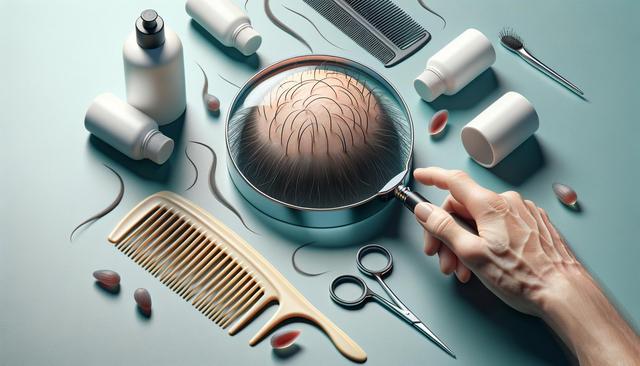Hair Loss in Men: Causes, Treatment, Diagnosis & Prevention
If your family has a history of male pattern baldness, you are more likely to experience it as well.

Understanding the Causes of Hair Loss in Men
Hair loss in men is a common condition that can begin as early as the late teens or early twenties. While it’s often attributed to aging, the underlying causes can be more complex. The most prevalent cause of hair loss in men is androgenetic alopecia, commonly known as male pattern baldness. This condition is largely hereditary, meaning if you have close relatives with hair loss, particularly on your mother’s side, your chances of experiencing it increase significantly.
Other contributing factors include hormonal imbalances, stress, poor nutrition, and certain medical conditions. In some cases, hair loss can be temporary, caused by factors such as medications, illness, or lifestyle changes. Recognizing the root cause is crucial for selecting the appropriate treatment option. Though often associated with men, hair loss can also affect women, and treatments like oral medication for hair loss female and hair loss female therapy options are increasingly being researched and developed.
How Hair Loss Is Diagnosed
Diagnosing hair loss in men typically begins with a clinical evaluation by a healthcare provider or dermatologist. The doctor will assess your medical history, family history, and any recent lifestyle changes that might be contributing to hair loss. A physical examination of the scalp is conducted to identify patterns of hair thinning or baldness.
In many cases, additional tests may be ordered, such as:
- Blood tests to identify underlying conditions like thyroid disorders or nutritional deficiencies
- Scalp biopsy to examine the hair follicles for signs of disease
- Pull tests to determine the strength and shedding rate of hair strands
These assessments help pinpoint the cause of hair loss and eliminate other potential disorders. It’s worth noting that while male pattern baldness follows a predictable pattern, other forms of hair loss may be more diffuse or patchy. For both men and women, understanding the diagnosis is essential before exploring advanced solutions like hair loss new treatment options or obtaining a prescription for hair loss female in cases of shared household concern.
Treatment Options for Male Hair Loss
There are several treatment strategies available for men experiencing hair loss, ranging from non-invasive topical solutions to more advanced medical and surgical interventions. The choice of treatment depends on the severity and cause of hair loss, as well as personal preferences and goals.
Common treatment approaches include:
- Topical applications that can slow hair loss and promote regrowth
- Oral medications that address hormonal causes
- Laser therapy to stimulate hair follicles
- Hair transplant surgery for more permanent results
Emerging studies continue to explore hair loss new treatment possibilities, many of which were initially tested or developed for hair loss female patients. Some oral medication for hair loss female options are now being studied for their potential benefits in men, demonstrating how research across demographics can lead to broader treatment possibilities.
Preventative Strategies for Hair Loss
Preventing hair loss before it becomes significant can be a more effective strategy than treating it after substantial thinning has occurred. While genetic predisposition cannot be changed, there are lifestyle and health habits that can help maintain healthier hair for longer.
Preventative measures include:
- Maintaining a balanced diet rich in vitamins and minerals
- Reducing stress through regular exercise, meditation, or counseling
- Avoiding harsh hair treatments or overuse of styling products
- Monitoring and managing underlying health conditions such as thyroid issues
Additionally, early consultation with a healthcare provider can help identify the first signs of thinning and allow for early intervention. Some men may benefit from treatments originally intended for female hair loss, like a prescription for hair loss female, adapted for male use under medical supervision. Proactive approaches are often more successful and less invasive than reactive treatments.
The Intersection of Male and Female Hair Loss Research
While hair loss affects both men and women differently, advancements in treatment have increasingly overlapped. Many medications initially developed for hair loss female patients are now being studied for male use, especially those that target hormonal imbalances. This crossover has broadened the scope of available therapies and introduced new oral medication for hair loss female options that may eventually benefit male patients as well.
Research into hair loss new treatment options continues to evolve, with a growing understanding of the biological mechanisms behind hair thinning. This has led to more targeted and effective therapies that consider both genetic and environmental factors. As male patients explore treatment, they may encounter terms like prescription for hair loss female or hair loss female in the literature or pharmacy, highlighting the shared direction in which this field is heading.
Ultimately, staying informed, seeking timely medical advice, and being open to emerging treatments can help men navigate hair loss with greater confidence and control.
Conclusion: Managing Hair Loss with Knowledge and Action
For many men, hair loss can be a challenging experience, both emotionally and physically. Understanding the causes, seeking early diagnosis, and exploring a wide range of treatment and prevention options can make a significant difference. Whether you’re noticing the first signs of thinning or managing a long-term condition, staying informed is key.
With continuous research and the adaptation of solutions like oral medication for hair loss female and hair loss new treatment options, the landscape of hair care is becoming more inclusive and innovative. By taking proactive steps and consulting with professionals, men can better manage hair loss and maintain a healthy scalp and hair for years to come.